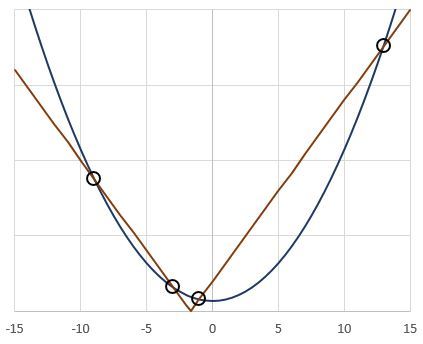Four times Four?
For positive integers and we define
One member of this family of equations would be , which has the solution set .
Which of the following sets of four is a solution set of an equation of this family?
This section requires Javascript.
You are seeing this because something didn't load right. We suggest you, (a) try
refreshing the page, (b) enabling javascript if it is disabled on your browser and,
finally, (c)
loading the
non-javascript version of this page
. We're sorry about the hassle.
A good place to start is a sketch of both sides of the equations in a graph. Clearly, the smallest two solutions belong to negative values of the argument of the absolute value, and the greatest two solutions belong to positive values.
For instance, for the equation x 2 + 7 = ∣ 1 2 x + 2 0 ∣ :
Call the solutions x 1 < x 2 < x 3 < x 4 , then the equation can be split out as { x 2 + a x + ( c + b ) = 0 x 2 − a x + ( c − b ) = 0 x = x 1 , x 2 x = x 3 , x 4 For quadratic equations, we know that the linear coefficient is the sum of the solutions (but with a negative sign), and the constant coefficient is their product. That is, { x 1 + x 2 = − a x 3 + x 4 = a x 1 x 2 = c + b x 3 x 4 = c − b Since a , b , c are positive, we see immediately that x 1 , x 2 must be negative and x 4 must be positive.This it the case for all solution sets listed, so we cannot rule anything out yet.
We also that the solutions must satisfy the equation x 1 + x 2 + x 3 + x 4 = ( − a ) + a = 0 . This, sadly, is also the case for all the solution sets listed.
Next consider the combination of x 1 x 2 = c + b and x 3 x 4 = c − b . Adding them we find x 1 x 2 + x 3 x 4 = 2 c . This implies, first of all, that x 1 x 2 + x 3 x 4 must be positive . This is obviously true if x 3 is positive, but if x 3 is negative we must check this condition. It turns out that the solution set { − 7 , − 3 , − 2 , 1 2 } fails this test, since 2 1 + ( − 2 4 ) < 0 .
It also implies that x 1 x 2 + x 3 x 4 must be even , since c is an integer. The condition x 1 + x 2 + x 3 + x 4 = 0 guarantees that zero, two, or four of the solutions are even; a problem occurs if both x 1 , x 2 are even and x 3 , x 4 are odd, or vice versa.
Thus we can rule out the sets { − 4 , − 2 , − 1 , 7 } and { − 8 , − 2 , − 1 , 1 1 } as they are even-even-odd-odd. (Don't be fooled by the order in which the numbers are listed!)
We find that the only candidate for the solution is { − 8 , − 7 , 2 , 1 3 } . It is straightforward to calculate that a = 1 5 , b = 1 5 , c = 4 1 so that the corresponding equation is x 2 + 4 1 = ∣ 1 5 x + 1 5 ∣ ∴ x ∈ { − 8 , − 7 , 2 , 1 3 } .
Note that if we remove the condition that c is an integer, we also have x 2 + 2 1 = ∣ 8 x + 7 2 1 ∣ ∴ x ∈ { − 4 , − 2 , − 1 , 7 } x 2 + 2 2 1 = ∣ 1 0 x + 1 3 2 1 ∣ ∴ x ∈ { − 8 , − 2 , − 1 , 1 1 } .